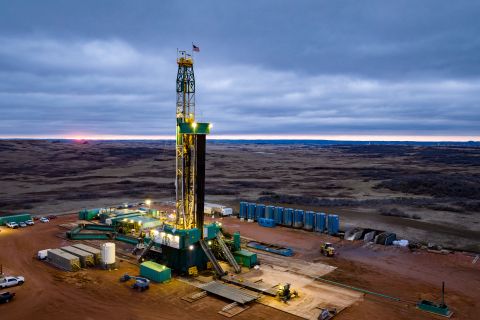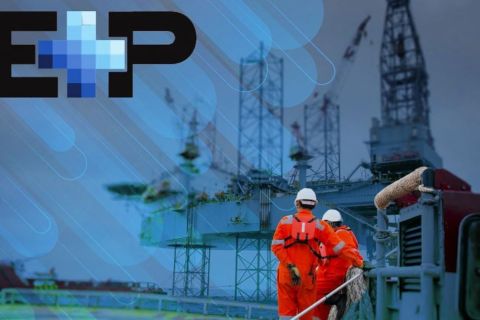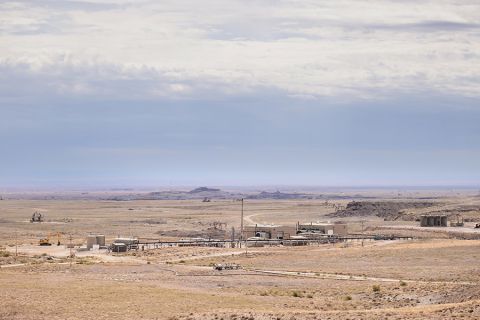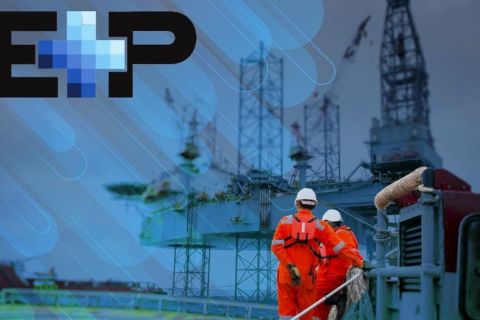Kinder: environmentalist strategy blocks midstream
An increasingly sophisticated environmental movement has exploited the pipeline permit approval process to hamstring energy companies, midstream titan Richard Kinder told attendees at the recent IHS CERAWeek conference in Houston, making clear that he wants the industry to fight back.
“It’s difficult to go up and shut down the oil sands,” the executive chairman of Kinder Morgan Inc. said of environmentalists during a discussion with Daniel Yergin, conference chairman and vice chairman of IHS. “It’s difficult to shut down the Eagle Ford or the Bakken or the Permian, but if you can stop pipelines from moving natural gas or crude oil or condensate, the theory is that you can put so much pressure on the upstream part of the business that you can have them quit drilling or slow down.”
A crew positions pipe for the Anchor Loop section of Kinder Morgan Inc.’s Trans Mountain Pipeline expansion. Completion of the system has been delayed by opposition from an environmental movement determined to stop the company from acquiring the necessary permits. Source: Kinder Morgan Canada Inc.
Prime examples of slowdowns include TransCanada Corp.’s Keystone XL Pipeline and Kinder Morgan’s own Trans Mountain Pipeline System, which is awaiting permit approvals to expand its capacity from 300,000 barrels per day (bbl/d) to 890,000 bbl/d of Canadian crude oil from Alberta to the Port of Vancouver, British Columbia. In the U.S., a lack of pipeline infrastructure to carry gas from the Marcellus and Utica shale plays has contributed to consumers in New England paying the highest rates in the country for natural gas and electricity.
“To me, it’s a very spurious argument in the sense that I don’t know what the hell they’re going to replace all this fossil fuel with,” Kinder said. “We can talk all we want about renewables and I’m a believer that we should do all of the above, but there’s no way, for example, to replace the impact of fossil fuels.”
The energy sector needs to promote its role as an important segment of the industrial sector, he urged.
“We have done more as an industry to advance the cause of raising living standards across the globe than any other industry I can think of,” Kinder said. “We need to do a better job of selling how important what we do really is. Sometimes I think we hide behind it like we’re selling cigarettes.”
Kinder later confessed to reporters that his company was taken aback by the ferocity of the campaign against Trans Mountain.
“Yes, I was surprised by the pushback,” he said. “I’m not asking to build a new line. This is a 300,000 bbl/d line and it has been around for 50 years. I’ve been astounded by all of the opposition, but almost all of it has been concentrated in the last 30 miles, which is the lower mainland. I think that a lot of this is just seeing the pipelines as a choke point to get at production in the oil sands. There are people in Canada and the United States who just want to strangle that altogether.”
The wide-ranging discussion also touched on crude by rail. Kinder, whose company operates 84,000 miles of pipelines, admitted to having adjusted his perspective and strategy.
“Rail has its place,” said Kinder, who added that the company’s 250,000 bbl/d-capacity Edmonton, Alberta, rail terminal is about to come online. “I used to not think that as a pipeliner. I thought, well, rail is an interim step and as soon as you can pipe something up, rail goes away.”
The volatility in crude prices cements rail’s place in the process, though Kinder maintains his view that pipelines are the safest and cheapest way to move hydrocarbons.
“I think you’re going to see, both on the supply side and the demand side, a preference for having part of the supply move out by rail,” he said.“I don’t know what that is— 10% or 20%—but with rail, you don’t have to make as long a commitment and you have more optionality to take into account the volatility of pricing. If one day you want to move it to Baton Rouge and the next day to
L.A. [to capture arbitrage], you can do that.”
DOT issues final crude oil, ethanol tank car ruling
The U.S. Department of Transportation released its long-anticipated final rule requiring a phase-out or retrofit of all legacy DOT-111 rail cars transporting crude oil and ethanol over the next eight years, by May 2023.
The final rule, developed by the Pipeline and Hazardous Materials Safety Administration and the Federal Railroad Administration, was broadened, extended and harmonized with Canada’s rule.
Specifically, the 395-page rule requires a phase-out or retrofit of all unjacketed CPC-1232 railcars used to ship ethanol by July 2023. Additionally, new tank cars constructed after Oct. 1 are required to meet the new DOT-117 design or performance criteria for shipping crude oil and ethanol.
As a result of the aggressive, risk-based approach, the final rule “will require replacing the entire fleet of DOT-111 tank cars for Packing Group I, which covers most crude shipped by rail, within three years and all non-jacketed CPC-1232s, in the same service, within approximately five years,” according to the DOT in a statement.
The new DOT-117 rail car will include a 9/16-inch steel hull, roll-over protection, full height head shields, top fitting protection and jacketing with thermal protection. Additionally, the rule requires a new braking standard for certain trains that will offer a superior level of safety by potentially reducing the severity of an accident, and the “pile-up effect;” designates new operational protocols for trains transporting large volumes of flammable liquids, such as routing requirements, speed restrictions and information for local government agencies; and provides new sampling and testing requirements to improve classification of energy products placed into transport. The brake standard caught many rail industry observers by surprise.
“Safety has been our top priority at every step in the process for finalizing this rule, which is a significant improvement over the current regulations and requirements and will make transporting flammable liquids safer,” U.S. Transportation Secretary Anthony Foxx was quoted as saying.
The rule addresses several recommendations made previously by the National Transportation Safety Board (NTSB), including: requiring enhanced safety features for tank cars carrying ethanol and crude oil and an aggressive schedule to replace or retrofit existing tank cars; requiring thermal protection and high-capacity pressure relieve valves for tank cars in flammable liquid service, expanding hazardous materials route planning and selection requirements for trains transporting flammable liquids; inspecting shippers to ensure crude oil is properly classified and requiring shippers to sufficiently test and document both physical and chemical characteristics of hazardous materials; and providing a vehicle for reporting the number of cars retrofitted. The NTSB first warned in 1991 that DOT-111 cars are inadequate for transporting hazardous materials. The newer CPC-1232 tank cars have been the rail industry’s standard since 2011. However, at least six major oil train accidents over the last 16months have involved the newer cars.
The rule, which inspired more than a year of furious lobbying by the railroad and energy industries, comes at a time in which the U.S. and Canada continue to rely on railroads for shipping crude oil—notably out of the Bakken in North Dakota—and ethanol out of the U.S. Midwest to key refining and terminal hubs.
“We are in the process of reviewing the [DOT] Enhanced Tank Car Standards and will have more to say once our analysis is completed. AFPM [American Fuel & Petrochemical Manufacturers] members, however, have demonstrated a commitment to improved crude-by-rail safety; voluntarily investing more than $4 billion to upgrade tank cars in advance of this regulation,” AFPM Executive Vice President Brendan Williams was quoted as saying.
Enterprise executive points to export need
The midstream must find new export markets for the nation’s surging NGL, condensate and light crude oil production, an Enterprise Products Partners LP executive told the 94th annual Gas Processors Association (GPA) conference in San Antonio. Domestic markets alone can’t absorb increasing shale-play production, said William Ordemann, group senior vice president, unregulated liquids, crude and natural gas services, for Enterprise.
“We are helping find markets for producers,” Ordemann said of his firm’s export push.“We have the supply, where is it going? … The water will get strategically more important over time.”
He estimated 500,000 bbl/d of ethane is being rejected into pipeline gas streams due to a lack of markets. “There’s plenty of ethane available, there will be a huge overhang even with the additional cracking capacity that will be coming on in the next few years.”
Enterprise’s 1,205-mile Atex Pipeline, which moves ethane out of the Marcellus and Utica plays to the petrochemical corridor around the Gulf Coast, is now handling 125,000 bbl/d, Ordemann said. Enterprise expects the system to move 190,000 bbl/d once ATEX attains full capacity in 2018.
Also, Enterprise started service on a 60-mile segment of its 270-mile Aegis Pipeline from the Mount Belvieu, Texas, NGL hub to Napoleonville, La., in late 2014. It closed an open season in May for the rest of the system, scheduled for completion by mid-2016. Aegis will form an ethane header system extending from Corpus Christi, Texas, to the Mississippi River when completed. The firm is adding a refrigerated ethane export dock to its Gulf Coast terminal assets that is expected to have a loading capacity of 240,000 bbl/d when it begins operations in third-quarter 2016.
Similar challenges exist for propane and butane, Ordemann said, noting “in a few short years we’ve gone from a net importer of propane to a net exporter.” Primary export markets have emerged in the Caribbean, Central and South America, he added.
Enterprise is considering a roundabout system that would move propane out of the Marcellus and Utica to the Conway, Kan., NGL hub. Only 60 miles in northern Illinois lie between two existing Enterprise pipelines, he noted. A new pipeline there, coupled with modifications to existing systems, could provide significant new propane capacity out of the northeastern plays.
The firm also is adding new propylene production capacity at Mont Belvieu that will require 35,000 bbl/d of propane when it goes online in September 2016.
Refracking presents opportunity for shale plays
Given today’s market conditions, refracking in hopes of boosting production from existing wells is prompting service companies to put the technique back in the spotlight.
“We’ve been refracking in essence for a couple of years, and we actually see this as a natural extension with the maturing of unconventional wells overtime,” Jeff Miller, president of Halliburton Co., said on a recent conference call. “What has changed in terms of giving it more energy right now is the current market and access to capital.”
Oil and gas companies are increasingly turning to technology and improved techniques to become more efficient and grow output as low oil prices slowly rebound amid a downturn marked by layoffs, mergers and cost cuts.
Refrack economics are attractive for bothHa lliburton and its clients, Miller said, before pointing out some of the company’s diverting technologies that specifically address refracking such as AccessFrac stimulation service.
The process, which targets cluster completion efficiency and cluster production efficiency, aims to help optimize proppant distribution for better production performance, the company said. Other technologies seek to identify the best candidates for refracking.
“I do believe we will see growth there,” Miller said.
He isn’t the only one. Schlumberger Ltd., the world’s largest oilfield service company, also believes the refracking market will expand. Much of the company’s focus lately has been on identifying refrack candidates based on existing completions data and finding the most effective refrack method while keeping costs down.
During Schlumberger’s first-quarter 2015 earnings announcement, the company highlighted the success of its BroadBand Sequence technology, which can be used to stimulate additional clusters.
The technology was used at one of Pioneer Natural Resource Co.’s previously fracked horizontal shale wells in the Eagle Ford. The result? The well’s oil and gas production increased by about 120% and 89%, respectively over the first 45 days after refracking, the company said.
The fracturing service also was used for Comstock Resources Inc. to refrack a well in the Haynesville Shale. Production jumped to 4 million cubic feet per day (MMcf/d) from 0.5 MMcf/d.
The key enablers are the ability of subsurface experts to identify the right well candidate and the technology, in this case BroadBand Sequence, to divert fracturing fluid into the perforations that haven’t properly been fractured in the first place, Schlumberger CEO Paal Kibsgaard explained on a conference call.
He believes thousands of shale liquids and gas wells in North America are refracturing candidates.
“I think you’re talking billions in terms of revenue opportunities over an extended period of time,” Kibsgaard added. “This is quite a significant market opportunity.”
Canada may catch up to U.S. in LNG export race, analyst says
In the race toward LNG exports in North America, the U.S. has a dominant lead over its neighbors to the north.
But in any competition, a big lead can always be overcome. For Canada, the collapse in crude oil prices might lower LNG-related costs for labor and pipelines, giving it the chance to be cost-competitive with the already thriving development in the U.S.
But that lead is awfully big.
“Some 50 million tonnes per annum of LNG production capacity is now under
construction in the U.S., compared to none in Canada,” Alex Munton, principal analyst of Americas Primary Fuel Fundamentals at Wood Mackenzie, said in a recent report.
The appeal of LNG exports for both countries is clear—natural gas shipments could mean significant investment, jobs and economic growth. Exports also provide a destination for the huge gas resource base in North America.
The key behind the different pace between the two countries has been cost. Nevertheless, Canada is still on the field and with prevailing market conditions, could even make a race of the LNG export business.
The oil price collapse has had little effect on the level of construction activity for LNG facilities in the Gulf Coast region of the U.S., which has easy access to a large local labor pool, the report said.
“For the U.S., the reduction of the U.S. Gulf Coast’s cost advantage does not jeopardize projects close to be sanctioned like Corpus Christi and nor does it preclude a second wave of U.S. LNG from getting sanctioned later,” Munton said.
Most of the big industrial projects are far too advanced to slow down now, Munton said. About 54 companies have applied to export LNG to federal trade agreement (FTA) and non-FTA countries. Companies continue to jockey for position, though out of all applicants, only eight companies have applied to export more than 2 billion cubic feet per day (Bcf/d).
The U.S. Department of Energy (DOE) has approved nine companies for exports to non-FTA countries. The U.S. has FTA agreements with Australia, Bahrain, Canada, Chile, Colombia, Dominican Republic, El Salvador, Guatemala, Honduras, Jordan, Mexico, Morocco, Oman, Panama, Peru, South Korea and Singapore.
If all applications were granted, roughly 47.5 Bcf/d would be exported to FTA countries and 40.31 Bcf/d to non-FTA countries.
LNG developers in the U.S. have focused on low-cost brownfield expansion where the incremental expenditure needed for LNG exports is primarily the cost of adding the liquefaction trains as well as some modifications to the existing marine facilities, storage tanks and pipelines, the report said.
All eyes turn to infrastructure
As the Obama administration released its recommendations to modernize the nation’s energy infrastructure in April, a midstream panel at the IHS CERAWeek conference also tackled the issue of how to handle the sudden bounty of U.S. hydrocarbons.
“The real driver of change in the United States in terms of oil supply is volume, location and quality,” said Sarah Ladislaw, director and senior fellow of the energy and national security program for Washington-based Center for Strategic & International Studies (CSIS), a bipartisan think tank. “To really understand the nature of that change, you’ve got to understand that. It’s not only that volume in general was increasing at a rapid pace, certainly overshadowing what we had previously been expecting for continental supply growth.”
Seven regions of the country have been predominantly responsible for the vast majority of the growth, Ladislaw said, with much of that growth representing new and different challenges for the previously held refining perspective, which was built to handle imported heavy crude and was faced with domestic light oil from shale plays.
“There was a mismatch between the infrastructure that we had and the infrastructure that we needed to be able to actively market the oil supply that was coming online,” she said.
Among the recommendations in the administration’s Quadrennial Energy Review:
• Accelerate pipeline replacement and enhance maintenance programs for natural gas distribution systems. In this initiative, the DOE would provide financial assistance to states in the range of $2.5 billion to $3.5 billion to incentivize improvements in the safety and environmental performance;
• Analyze the Strategic Petroleum Reserve (SPR) to determine an appropriate size and configuration, then make an expected $1.5 billion to $2 billion investment in infrastructure life extension;
• Update SPR release authorities to reflect modern oil markets;
• Spend $4 billion to $5 billion to improve shared energy transportation infrastructure connectors (rail, barge, truck);
• Address critical energy transportation
data gaps and continue to share data with the Surface Transportation Board; and
• Examine alternative financing arrangements for waterborne transportation infrastructure and look for public-private partnerships to finance port and waterway improvements.
“Pipelines, obviously, are still the dominant way of moving crude oil within the country, but this surge of not only additional rail capacity but also oil being carried by barge and other modes of transportation is really something that pol-cy makers are particularly interested in,” Ladislaw said.
Will a ‘circular economy’ be unbroken?
The energy industry faces a major challenge from an environmental movement determined to sharply reduce—if not end—the use of hydrocarbon fuels, according to author and researcher Amy Myers Jaffe.
“You don’t think like the millennials on energy,” she said in her keynote address to the Gas Processors Association convention. “The most powerful part of the movement is consumer activism” that seeks total use of renewable energy and consumer products—“a circular economy” in which waste and pollution are minimized—even at the cost of economic advancement.
“This is going to become a big feature” in future years, she cautioned the audience of more than 2,400 midstream business leaders.
The circular economy emphasizes biological sustainability, an approach opposite to a traditional linear economy in which resources are found, put to use in an economic system and then disposed. An author and contributor to various news organizations, Myers Jaffe is now executive director for energy and sustainability at the University of California-Davis. Previously, she was with Rice University’s James A. Baker III Institute for Public Policy.
In a wide-ranging address, she compared current world events to predictions she made in a keynote speech at GPA’s annual meeting in 2005. Some of her points proved to be correct, for example noting at that time that upstream independents were outspending the majors and super majors on E&P.
“At the time, a lot of people said that doesn’t matter because the independents didn’t have a large role in the industry,” she said. However, the independents led the breakthrough in development of the unconventional shale plays in North America— something that has fundamentally changed the world energy business.
Another point she made 10 years ago was the historic but growing conflict between the Sunni and Shia sects of Islam in the Middle East. The conflict currently plays out in proxy wars in Yemen, Syria, Iraq and elsewhere between Sunni Saudi Arabia and Shiite Iran.
But the researcher admitted to missing some points a decade ago, such as projecting continuing increases in energy prices into the foreseeable future. The 2008 to 2009 recession and the current commodity price downturn proved that view to be incorrect.
Instead, “there is a pattern of [energy] in-ustry cycles that go back to the 1800s,” she said.“We’re seeing it again today, connected to the current global cycle.”
Capital surge helps E&Ps hang on to midstream asset
Tudor, Pickering, Holt & Co. said Kinder’s comments confirm that a recent wave of E&P equity issuances has taken pressure off of upstream operators to divest their midstream assets.
E&Ps have come to the equity market and to a lesser extent the debt market at an unprecedented rate, Daniel P. Katzenberg, analyst, Baird Equity Research, wrote in a recent report. Some companies have shored up liquidity and balance sheets ahead of a potentially prolonged retrenchment in hydrocarbon pricing, Katzenberg said. Along with equity, debt issuances have tallied about $5.9 billion.
Deals remain in focus for lenders and operators. “In early 2015, the focus was which E&Ps would go out of business,” Katzenberg said. “However, similar to past cycles, financial markets and partner banks have willingly bailed out E&Ps in a flurry of deal activity. Given the emphasis on balance sheets of late, recent equity deals have been given a pass, despite the significant dilution.”
Katzenberg said that Royal Dutch Shell Plc’s deal to buy BG Group Plc for $70 billion has “rekindled M&A animal spirits.
“U.S. energy investors’ hopes for consolidation in the energy sector have been set alight,” he said, especially in light of billions in financing.
IEA: global oil demand rising
The International Energy Agency (IEA) found in a recent “Oil Market Report” that global oil demand for 2015 is now seen rising by 1.1 million bbl/d (MMbbl/d), to a total of 93.6 MMbbl/d, thanks to a “steadily improving global economic backdrop.” Meanwhile, global refinery crude runs are expected to fall seasonally to 77.3 MMbbl/d in second-quarter 2015, from 78 MMbbl/d in first-quarter 2015, according to the agency.
“While Atlantic Basin refiners mostly completed turnarounds in 1Q 2015, Asian refinery maintenance is set to ramp up sharply in 2Q 2015, with up to 2.5 million bbl/d of distillation capacity offline at its peak in May,” according to the IEA.
“Weaker than expected throughputs for a number of non-OECD countries and unexpectedly strong product demand supported margins, providing OECD refiners with an incentive to use surplus capacity.

“Current estimates peg 1Q-2015 OECD [refinery crude] runs up 900,000 bbl/d from a year earlier, while estimated non-OECD growth has been cut to less than 300,000 bbl/d,” according to the agency.
“Unexpected demand strength in crude and product markets has boosted refining margins in some of the very markets where demand had seemed to be the weakest. European product demand, long in secular decline, swung back to growth in some markets in early 2015, and the region’s refining sector has found renewed vigor amid weaker-than-expected runs elsewhere,” according to the IEA. Meanwhile, according the the report, "non-OECD refinery runs look on track to post year-on-year growth of just 250,000 bbl/d for 1Q 2015, their weakest annual increase since 2009.”
MLP experts shed light on rulemaking by IRS
After the Internal Revenue Service filed a notice of proposed rulemaking (NOPR) in May to develop standard guidance regarding MLP-qualifying income, analysts and legal experts began to unravel implications for the energy industry.
In a note from Raymond James, Darren Horowitz and J.R. Weston described the most significant changes: the decision that “certain limited support activities that are ‘intrinsic’ to qualified activities”—but are not qualified activities themselves—would qualify for MLP status; and ethane and propane “chemically converted into refinery-grade olefins byproducts” would likely not qualify for MLP status.
Regarding oilfield support services, tax lawyer Barbara S. de Marigny with McGuireWoods LLP told Midstream Business the question has always been,“'How far away from the wellhead can you get and still have it be related to the exploration and production of oil and gas? What these rules do … is they set up this whole new category of qualifying income—other services to the oil and gas drillers that are considered to be ‘intrinsic,’” she said.
The proposed rules establish a “three-part test” for determining whether an activity is intrinsic, she said. The test examines: whether the activities are specialized to oil and gas; whether the activities are essential, or necessary to the completion of oil and gas activity; and whether the activity is significant. Regarding the significant standard, de Marigny said the thought process behind the standard was that, “in connection with this income from this activity, there has to be a substantial services component.”
“What they’re trying to get at is this situ-aton where somebody goes out to the wellhead and just sells drill bits, for example,” she said.“Well, that’s essential to the drilling, that’s specialized to the drilling, but there’s no service involved in it. They’re just selling a product.”
As for the rule and its relation to olefin production, a McGuireWoods note said,“In general, the proposed rules bless products that are byproducts of natural resource processing but exclude products derived by adding or mixing other substances into the product.”
Examples listed in the NOPR clarified that an MLP that chemically converts ethane and propane into ethylene and propylene via a steam cracker would not be allowed to consider income from the sale of the resulting olefins as qualifying income.
“Basically, what they’re saying is if you are merely purifying the natural resource, so you’re separating things out of it, then the result of that process is going to be good processing activity,” producing qualifying income, de Marigny said.
Typically, when legislation gives such broad guidelines, the IRS will follow up with more extensive regulations giving detailed guidance, de Marigny said. However,“in this area for whatever reason, the IRS never put out regulations that described in detail their view of what exactly was meant.”
Recommended Reading
Smart Tech Moves to the Hazardous Frontlines of Drilling
2024-10-08 - In the quest for efficiency and safety, companies such as Caterpillar are harnessing smart technology on drilling rigs to create a suite of technology that can interface old and new equipment.
Baker Hughes Defies Nature with an Upgrade to Ol’ Fashioned Cement
2024-10-15 - Baker Hughes’ InvictaSet uses regenerative capabilities to provide operators with a sustainable cement solution that can last for years.
E&P Highlights: Sept. 23, 2024
2024-09-23 - Here's a roundup of the latest E&P headlines, including Turkey receiving its first floating LNG platform and a partnership between SLB and Aramco.
Now, the Uinta: Drillers are Taking Utah’s Oily Stacked Pay Horizontal, at Last
2024-10-04 - Recently unconstrained by new rail capacity, operators are now putting laterals into the oily, western side of this long-producing basin that comes with little associated gas and little water, making it compete with the Permian Basin.
E&P Highlights: Aug. 26, 2024
2024-08-26 - Here’s a roundup of the latest E&P headlines, with Ovintiv considering selling its Uinta assets and drilling operations beginning at the Anchois project offshore Morocco.
Comments
Add new comment
This conversation is moderated according to Hart Energy community rules. Please read the rules before joining the discussion. If you’re experiencing any technical problems, please contact our customer care team.





